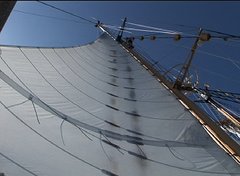The routine of the ship runs now like clockwork - with watches (groups of students) rising and relieving one another with an energy and enthusiasm that reminds me of when I was a student aboard Westward. Our students are carrying on the continuous rhythm of the ship's mission: research, sailing, cooking meals, catching fish (wahoo and tuna) and simply experiencing high seas sailing.We've just passed the point where we're farthest away from land. With winds as strong as 30 knots and almost all the sails of the tall ship up, it almost feels like flying. And at night, with starlit skies, our bow is directly pointed at the Southern Cross which rises higher each night. The stars and planets are intense in the evening sky. Venus is brighter than I've ever seen it. A sliver of the moon rises early in the evening. One understands how Polynesian voyagers could use the star Arcturus to navigate as it rises prominently in the evening sky.
 The students have been collecting sun and star sights with their sextants and calculating our position. Jess McNally was the first to put a position on the chart, and, using astronomical math, was within 5 nautical miles of the GPS positions. This group is among the strongest we've had in navigation and nautical science, which met daily in the shore component and continues here in a practical context at sea. Their enthusiasm for using the sextant, shooting local apparent noon sights, and learning is almost insatiable. Del Rego commented today that nautical science might be the most practical course he's ever taken at Stanford - "I'm learning about the planet". Captain Phil and engineer Dusty are working daily on sextant handling, reduction of the positions and teaching how to use the stars to navigate.
The students have been collecting sun and star sights with their sextants and calculating our position. Jess McNally was the first to put a position on the chart, and, using astronomical math, was within 5 nautical miles of the GPS positions. This group is among the strongest we've had in navigation and nautical science, which met daily in the shore component and continues here in a practical context at sea. Their enthusiasm for using the sextant, shooting local apparent noon sights, and learning is almost insatiable. Del Rego commented today that nautical science might be the most practical course he's ever taken at Stanford - "I'm learning about the planet". Captain Phil and engineer Dusty are working daily on sextant handling, reduction of the positions and teaching how to use the stars to navigate. Over in science, the turtle team continues sampling along the frontal boundary where the northern equatorial current meets the counter current. Using temperature and salinity along with chlorophyll as a cue, we've focused in on our second station of three. At midnight we conducted a long three-hour station. Our meter net was filled with the jelly biomass of siphonophores and pyrosomes that lit the evening with their remarkable flaming bioluminescence. While conducting the station, squid filled the evening lights and flying fish were so plentiful they were jumping right into the boat - this shows the richness of the frontal edge.
Over in science, the turtle team continues sampling along the frontal boundary where the northern equatorial current meets the counter current. Using temperature and salinity along with chlorophyll as a cue, we've focused in on our second station of three. At midnight we conducted a long three-hour station. Our meter net was filled with the jelly biomass of siphonophores and pyrosomes that lit the evening with their remarkable flaming bioluminescence. While conducting the station, squid filled the evening lights and flying fish were so plentiful they were jumping right into the boat - this shows the richness of the frontal edge.Christmas Island lies 4 days ahead and our students with Line Island projects are memorizing fish, preparing their gear, and sorting out field plans. But for now, we have fallen into a routine of sailing ever southward, with a warm breeze out of the northeast and twice daily station stops punctuated by afternoon all-hands meetings. We are a happy ship. -- Barb Block and Rob Dunbar, chief scientists


No comments:
Post a Comment